Monitoring stress from the surface of the body
Researchers at the University of Illinois Urbana-Champaign are exploring how wearables and surface sensors can provide insight into human stress — mental, emotional, physiological — by measuring signals from the body surface. The work is part of the Carle Illinois College of Medicine’s Department of Biomedical and Translational Sciences, with interdisciplinary collaboration spanning bioengineering, health & kinesiology, neuroscience, and behavioral sciences. The goal is to better understand how stress manifests physically, to enable better tools for detection, monitoring, and possibly interventions.
What the Researchers Measure & How
To monitor stress non-invasively, the UIUC team uses a combination of wearable sensors and lab tests, measuring several physiological signals from surface locations:
| Signal / Measurement | What is measured / how | What it tells about stress |
|---|---|---|
| EEG (electrical activity of the brain) | A swim cap with ~64 electrodes on the scalp; electrodes use conductive gel, multiple channels monitored. | Variations in brain electrical activity can indicate changes in arousal, attention, anxiety, or discomfort. |
| Heart rate & breathing / respiration | Using a “smart shirt” with embedded sensors wrapped around the torso. | Heart rate increases under stress; breathing becomes shallow or faster; patterns of breathing can shift. |
| Electrodermal activity (EDA) | Wristband worn on non-dominant hand. Measures skin conductance (sweating, micro-changes in skin moisture). | Reflects sympathetic nervous system activation (sweating increases under stress). |
| Skin temperature | Also via wristband and possibly other surface sensors. | Stress changes skin perfusion; may reduce peripheral temperature (vasoconstriction) or cause fluctuations. |
| Blood volume / pulse amplitude / photoplethysmograph-type signals | Wrist or perhaps sensors in the shirt. Measures blood volume changes per pulse. | Changes in pulse volume or blood flow are influenced by stress, for instance via vasoconstriction or changes in cardiac output. |
| Muscle tension (EMG) | Surface electromyography sensors attached to neck, shoulders, arms, torso. | Stress often causes involuntary tightening of muscles; EMG can reflect increased muscular activation or tension. |
To provoke stress (so that they can measure responses), the researchers employ standardized psychological / physiological challenge tasks such as:
- Cold Pressor Test: Immersing a hand in ice water, to evoke pain / discomfort stress.
- Trier Social Stress Test: Having participants prepare and deliver a speech, perform mental arithmetic under observation — social evaluative threat.
- Stroop Test: Tasks involving cognitive interference (naming the ink color vs reading the word), under seated or walking conditions. This adds cognitive load under time pressure.
Measurements are made both under baseline / rest (after a relaxation period, e.g. meditation) and during stressors. The wearable suite includes many sensors but is still designed such that participants can move naturally through many tasks. After lab experiments, participants may take home kits of wearable devices for monitoring in everyday (real-world) life.
Findings & Early Results
From what is publicly reported so far:
- The measured physiological signals do indeed change with different stressors. Heart rate, electrodermal activity (EDA), skin temperature, muscle tension, etc., show variation in response to both physical (cold) and social / cognitive (speech, Stroop) stressors.
- The data collected is rich enough to allow model building: researchers mention they are developing predictive models (e.g. using data from “smart shirts” during exercise) to differentiate between individuals at higher or lower risk of heart-related ailments. Also, models relying on wearables to predict anxiety even without prior individual training are being explored.
- The combination of multiple signal modalities seems useful: having EEG + peripheral sensors + EMG + heart / breathing gives a more complete picture than any single sensor alone. This multimodal approach helps in disambiguating what kind of stress (physical, cognitive, social) is present.
Technical & Practical Challenges
The researchers also confront a number of challenges, some of which are already partially addressed; others remain open:
- Signal quality and noise
- Attaching electrodes (especially EEG) requires care: conductive gel, adjusting electrodes, ensuring low impedance etc. Movements, sweating, or motion artifacts can degrade signal.
- Wearables (shirts, wristbands) must balance comfort and snugness; loose sensors degrade data, tight ones may be uncomfortable.
- Calibration at individual level
- People vary a lot in baseline physiology (resting heart rate, muscle tone, sweat response). Models must account for inter-subject variability.
- To generalize to “in the wild,” training must include many individuals, and likely some personalization.
- Distinguishing types of stress and confounds
- Physical stressors (cold, exertion) vs psychological stressors (social evaluation) may cause overlapping but distinct sensor signatures.
- Other non-stress causes (e.g. ambient temperature, physical activity, caffeine, health status) can influence many physiological variables. Must be controlled for or measured.
- Moving from lab to real life (ecological validity)
- In lab, tasks are well-defined; in daily life, stressors are messy and not labelled.
- Wearable kits for home use help, but cause trade-offs: comfort, battery life, sensor robustness, data storage, participant compliance.
- Data processing & modelling
- Multi-sensor datasets are complex (many channels, different sampling rates, different noise profiles).
- Models need to handle time-series, latency between stressor onset and physiological response, possible delayed recovery.
- Issues of privacy, ethical use of data, and data security when collecting continuous multisensor physiological data.
Implications & Potential Applications
This kind of stress monitoring research has several potential uses, spanning healthcare, personal wellness, occupational health, and more.
| Use Case | How this research contributes |
|---|---|
| Mental health diagnostics / treatment | More objective measures of anxiety, stress disorders; monitoring treatment efficacy; early detection of escalating state before it becomes clinically problematic. |
| Wearable health & wellness devices | Smartwatches, smart shirts, fitness trackers could incorporate more advanced stress detection (beyond heart rate / HRV) to offer feedback or suggestions (e.g., breathing exercises). |
| Occupational health | Jobs with high stress (customer service, public safety, emergency medicine) might benefit from real-time or periodic monitoring to prevent burnout, reduce errors, improve safety. |
| Sports and performance | Athletes, performers, or other high-pressure roles may benefit from monitoring stress to optimize training, recovery, peak performance. |
| Research / neuroscience | Better data for understanding how stress affects the brain and body, and how different stressors manifest differently; may feed into understanding of chronic stress effects. |
| Real-world adaptive systems | Devices and systems that can adapt behavior by detecting user stress — e.g. adjusting workload, interruption levels, or providing supportive interventions (e.g. prompts, adjustments in environment). |
Monitoring stress from the surface of the body – News Bureau
Today, my laboratory looks more like a scene from a sci-fi film than a psychology research space. Wires snake across tables, sensors lay carefully arranged on trays, and a bucket of ice water sits in the corner, quietly waiting its turn.
This work is part of the University of Illinois Urbana-Champaign’s department of biomedical and translational sciences at the Carle Illinois College of Medicine. The college is training a new generation of physicians to develop transformative health care solutions by integrating engineering, science and medicine. This experiment is meant to help us understand how stress affects the body and mind, and to develop devices that will aid in diagnosis, monitoring and treatment of mental health symptoms, such as anxiety.
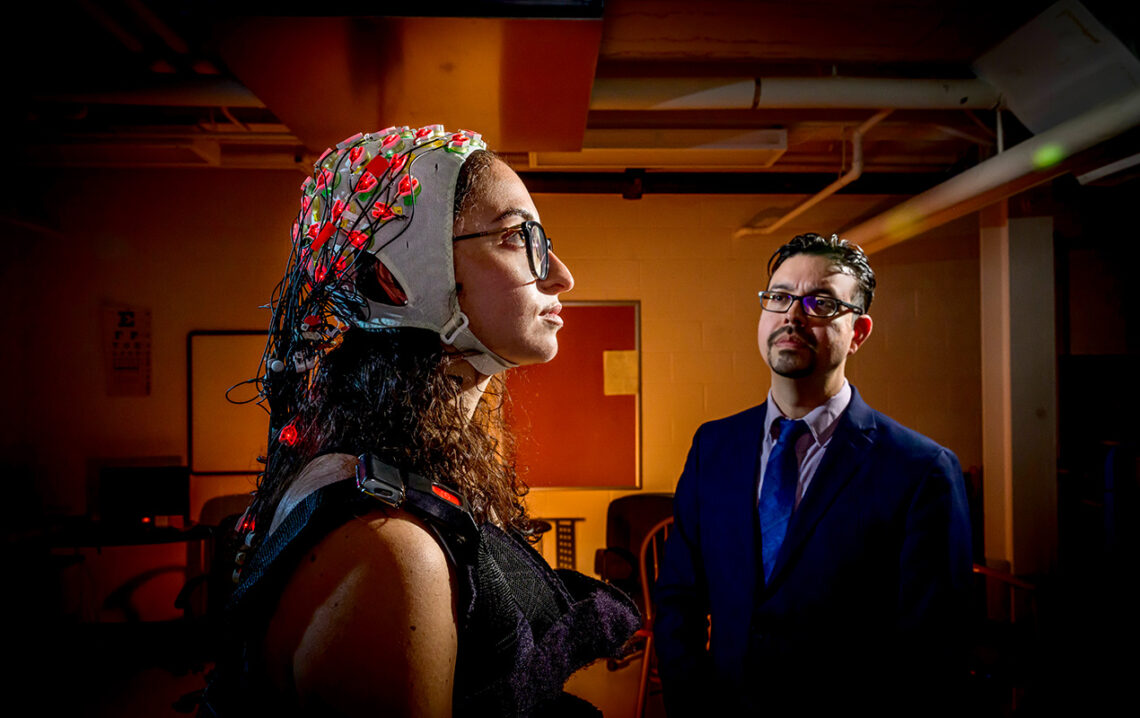
Photo by Fred Zwicky
Our brains sometimes respond excessively to social, physical and mental challenges, and even to benign objects. We want to better understand an individual’s responses to such stresses.
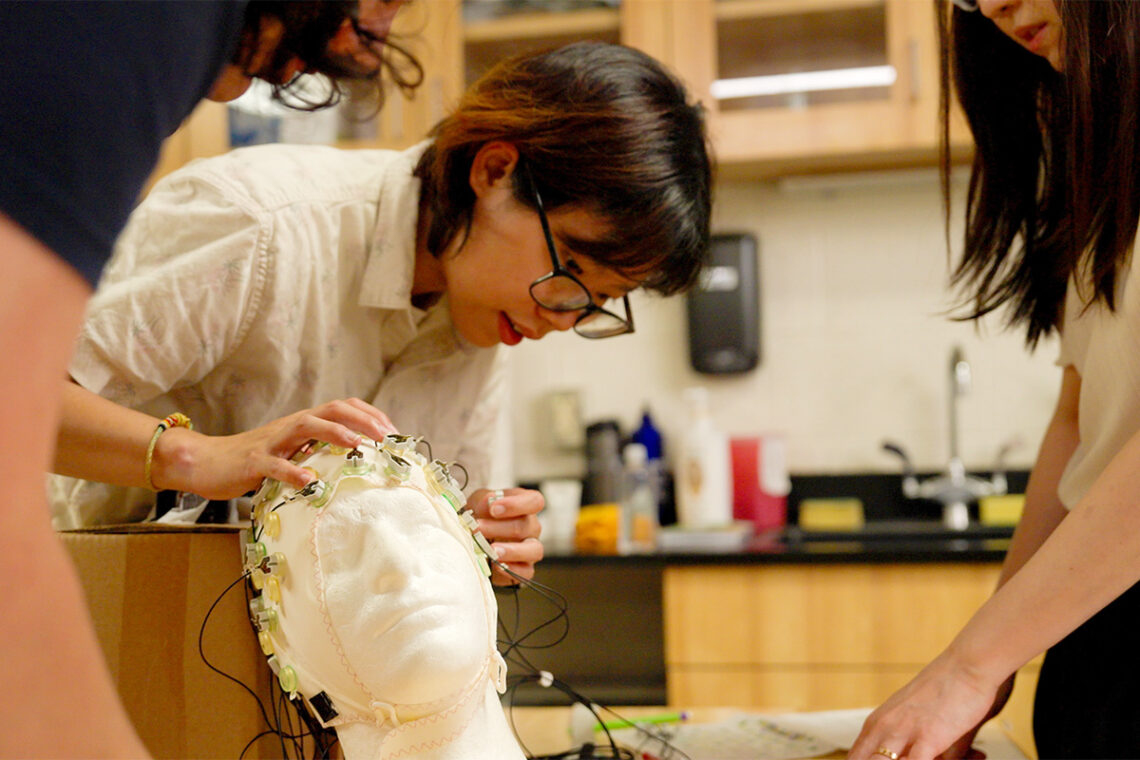
We have gathered numerous wearable devices, including caps, wristbands and “smart shirts.” These devices can monitor participants’ brain activity in controlled settings, giving us insight into how people respond in real-world scenarios.
A participant enters the room, and we prepare a cap for them that is studded with electrodes to monitor electrical activity in their brain. The electrodes are carefully positioned on the person’s scalp to capture the electrical symphony of the brain.
Getting good signal quality requires patience. We must apply conductive gel to each of 64 colored channels, adjusting and readjusting until the numbers turn green on our monitors, indicating each signal is coming through clearly.
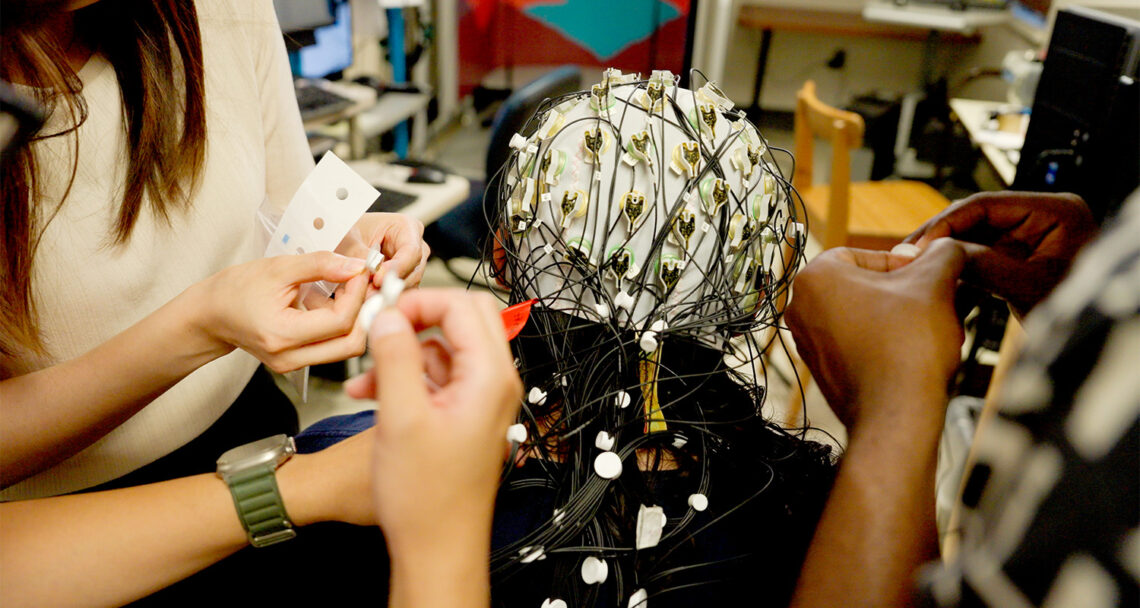
Next, we wrap a smart shirt snugly around the participant’s torso. Its embedded sensors monitor the person’s heart rate, breathing patterns and movement with every breath and heartbeat. We place a wristband over their nondominant hand. This will track electrodermal activity, skin temperature and blood volume per pulse. Finally, we attach electromyography sensors to the person’s neck, shoulders, arm and torso to capture muscle tension.
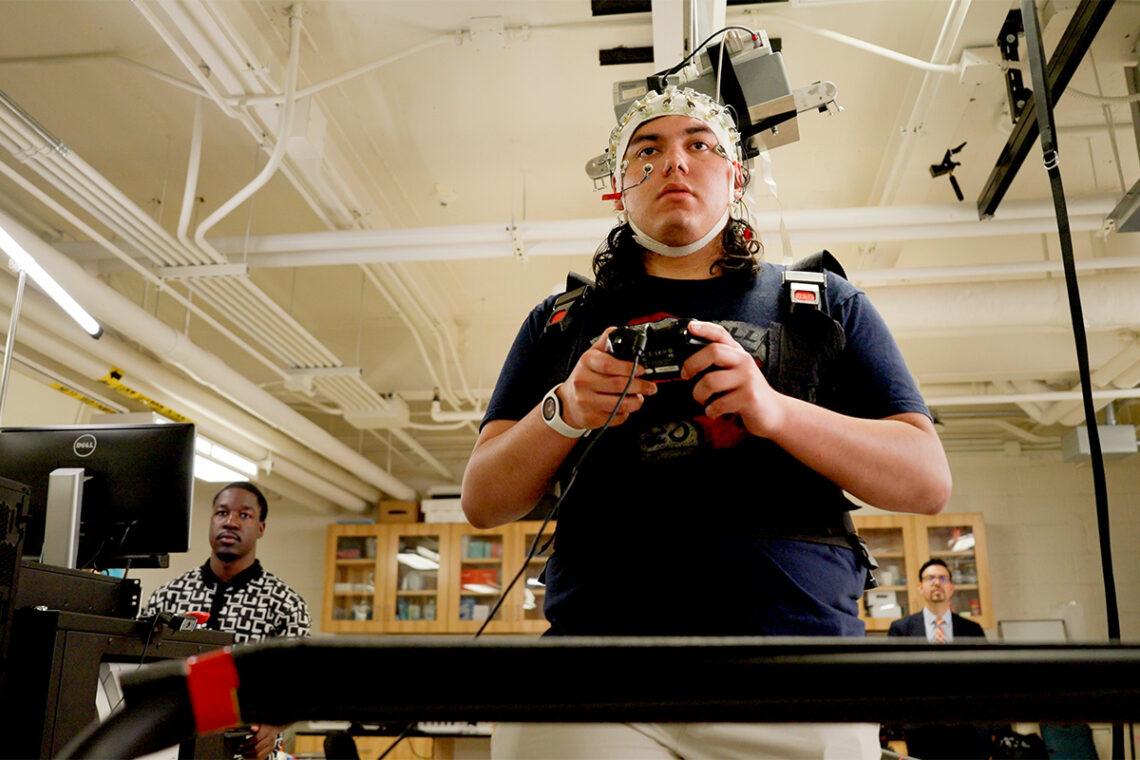
By the time we finish this process, each participant is adorned with multiple sensors and wires but is still able to move naturally through the experimental tasks thanks to the wearable technology.
To help participants return to a more restful baseline after the initial setup, we guide them through a five-minute meditation. Then we start the first challenge: the cold pressor test.
On paper, the test seems straightforward: We ask each participant to immerse their hand in ice water for up to one minute. But in practice, we quickly learn that every participant’s pain threshold differs. Some barely flinch; others can’t keep their hands in the ice water more than 30 seconds.
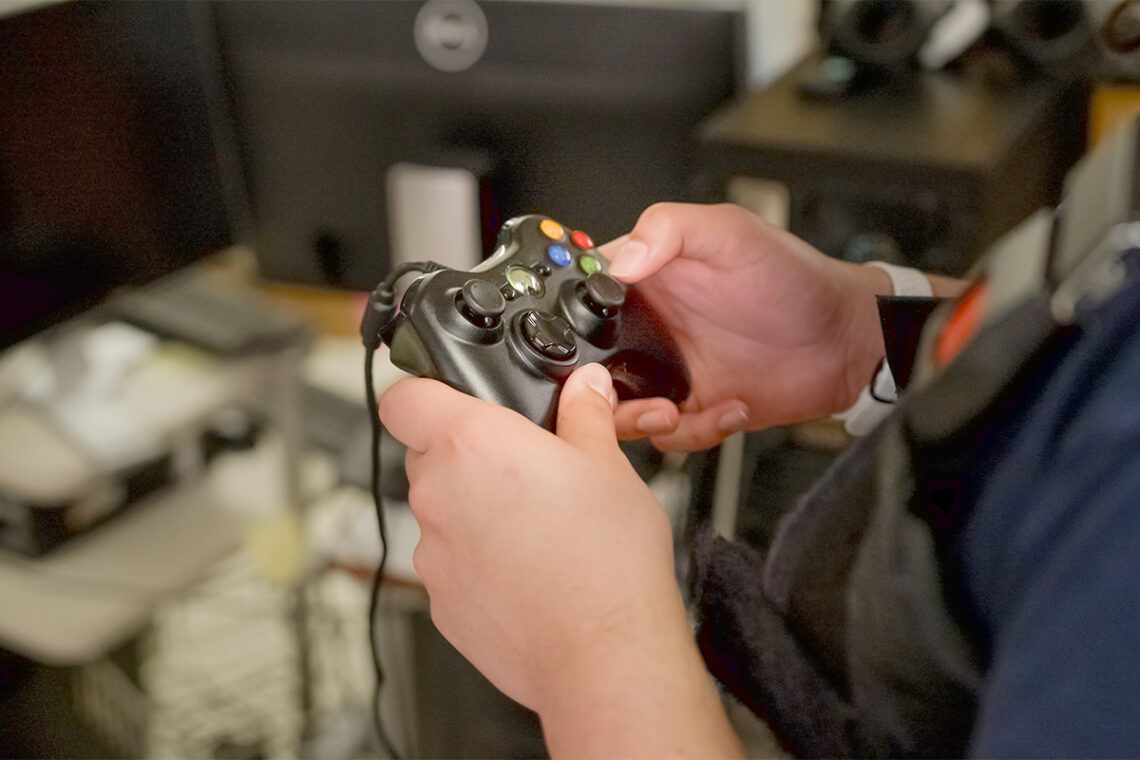
For the next part of the experiment, I am out of the room. I must call in from a remote location via Zoom while my graduate student, Maxine He, guides the participant through the exercise. She tells the student that the interview with me will begin immediately. The short notice often catches the person off guard, amplifying the stress of being judged in a public setting. This is the Trier Social Stress Test, our powerhouse stressor.
The test asks participants to deliver a three-minute speech, then solve a mental arithmetic task, all while being observed by me and the research team. We maintain poker faces throughout the task, giving the participant no clue as to how they’re doing.
The anticipation alone sends participants’ blood levels of the stress hormone cortisol climbing.
Some participants step up to the challenge with confidence, filling the speech period with ease, their words flowing naturally despite the team of people watching them. Others struggle to reach the three-minute mark. They run out of things to say and fall into uncomfortable silences that stretch on while we maintain our neutral expressions. Some people’s voices waver or their hands tremble as they try to recall their prepared points.
The physiological data collected by our sensors tells stories the participants themselves can’t always articulate. Heart rates spike during the long pauses and electrodermal activity increases.
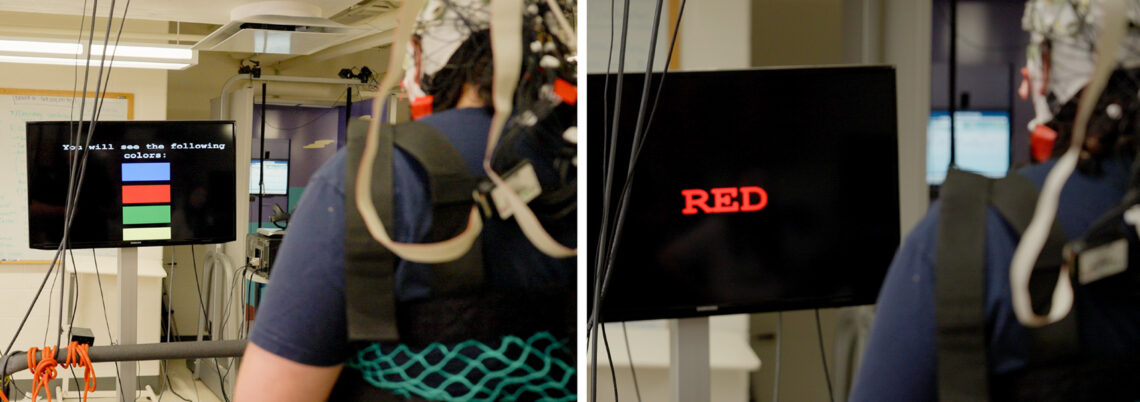
Another test, called a Stroop Test, adds cognitive interference to the mix of stressors. While seated or walking on a treadmill, participants must perform a thinking task that requires a quick response to visual stimuli. The task involves reading the names of colors that are printed in the same, or a different, color. This exercise seems trivial until you’re doing it under time pressure while also walking on a treadmill and wearing numerous sensors. The seated version is challenging enough; the walking version adds a layer of complexity that makes the task particularly rich for studying anxiety.
At the end of the session, we answer participants’ questions, then lead them to a place to change while we load all the data. Then we prepare for the next stage, where we send each participant home with a kit of wearable devices to monitor their bodies’ responses to the challenges of everyday life.
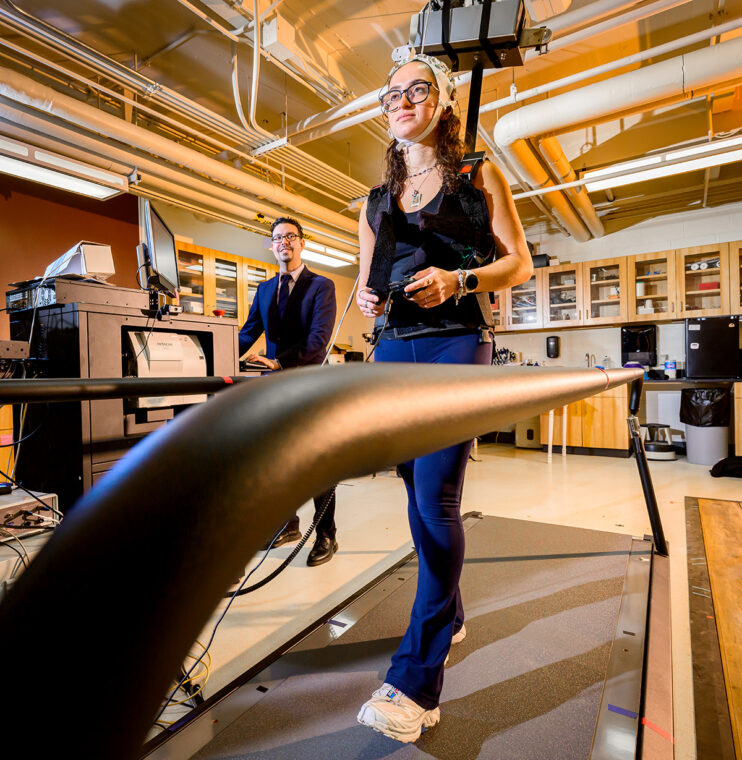
Our work with smart technology has already yielded some useful applications. Earlier this year, we developed a tool for analyzing data from a smart shirt worn during exercise to predict those at higher or lower risk of heart-related ailments. We are also developing models that rely on data from wearables to predict anxiety in users, even without any prior training.
The idea of this work is to make the task of diagnosing and tracking anxiety easier and less costly, and to understand the various physiological responses to stress so that we can better manage it.
This work is supported by the National Center for Supercomputing Applications and a Jump ARCHES endowment through the Health Care Engineering Systems Center at Illinois and the OSF Foundation.
